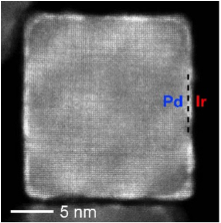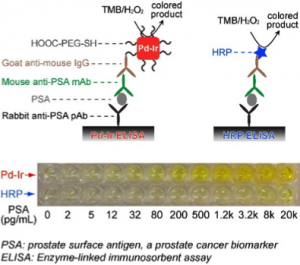18 Sep Nanotechnology Can Improve PSA Sensitivity and Efficiency
 MedicalResearch.com Interview with:
MedicalResearch.com Interview with:
Dr. Xiaohu Xia Ph.D.
Assistant Professor
Department of Chemistry
Michigan Technological University
Houghton, MI 49931
Medical Research: What is the background for this study? What are the main findings?
 Dr. Xia: Peroxidases, a family of enzymes that catalyze the oxidation of certain compounds with peroxides, have found widespread use in areas such as biomedicine and environmental protection. Over the past several years, researchers have found that certain inorganic nanomaterials (such as nanoparticles made of metal, metal oxides, and carbon) possess intrinsic peroxidase-like activities. As the major advantage over their natural counterparts, these peroxidase mimics are much more stable because they are less vulnerable to denaturation and protease digestion. In spite of the superior stability of the mimics, improvement in their catalytic efficiency has been met with limited success. The catalytic efficiencies for most of the previously reported peroxidase mimics with sizes 1-100 nm are limited to the range of 101-104 s-1 in terms of catalytic constant (Kcat, which measures the maximum number of chemical conversions of substrate molecules per second per enzyme/mimic).
Dr. Xia: Peroxidases, a family of enzymes that catalyze the oxidation of certain compounds with peroxides, have found widespread use in areas such as biomedicine and environmental protection. Over the past several years, researchers have found that certain inorganic nanomaterials (such as nanoparticles made of metal, metal oxides, and carbon) possess intrinsic peroxidase-like activities. As the major advantage over their natural counterparts, these peroxidase mimics are much more stable because they are less vulnerable to denaturation and protease digestion. In spite of the superior stability of the mimics, improvement in their catalytic efficiency has been met with limited success. The catalytic efficiencies for most of the previously reported peroxidase mimics with sizes 1-100 nm are limited to the range of 101-104 s-1 in terms of catalytic constant (Kcat, which measures the maximum number of chemical conversions of substrate molecules per second per enzyme/mimic).
Our research team have recently developed a new type of peroxidase mimic with a record high efficiency that was engineered by coating ~18 nm palladium (Pd) nanocubes with ultrathin iridium (Ir) skins of a few atomic layers (i.e., Pd-Ir core-shell cubes, see Figure). The catalytic efficiency of our Pd-Ir cubes could reach a level of Kcat = 106 s-1.
In view of the substantially enhanced efficiency, we applied our Pd-Ir cubes to the colorimetric enzyme-linked immunosorbent assay (ELISA) of human prostate surface antigen (PSA) by functionalizing their surface with antibodies. The detection limit of the Pd-Ir cubes-based ELISA of PSA was determined to be 0.67 pg/mL, which is over 100-fold lower than that of the conventional horseradish peroxidase(HRP)-based ELISA using the same set of antibodies and the same procedure (see Figure).
 Medical Research: What should clinicians and patients take away from your report?
Medical Research: What should clinicians and patients take away from your report?
Dr. Xia: PSA test measures the level of PSA in a man’s blood, which is done to help diagnose and follow prostate cancer. In particular, for patients who have undergone radical prostatectomy, it is vital to monitor minute concentration of PSA at the earliest stage possible to improve their survival rates. Therefore, sensitive and simple techniques of PSA test are urgently needed, especially for health systems in resource-limited areas.
Our Pd-Ir cube-based ELISA offers several advantages compared to existing techniques of PSA test:
- i) High sensitivity. Its detection limit (sub-pg/mL) is 2 orders of magnitude lower than the commercially available in-clinic ELISA kit, rivaling the limits of sophisticated equipment-based techniques;
- ii) Simple procedure. The entire test could be completed within 3 hours with the aid of a simple and low-cost microplate reader which is available in most clinic laboratories;
- iii) Reliable performance. Since Pd-Ir nanocrystals are made of inert noble metals with excellent stabilities, the Pd-Ir ELISA could survive harsh environments and provide reliable test results.
Medical Research: What recommendations do you have for future research as a result of this study?
Dr. Xia: Our work demonstrated that the peroxidase-like activity could be enhanced by carefully engineering the structure and elemental composition of a mimic. Future fundamental studies on the catalytic mechanism will be helpful for researchers to gain more insight into the system and develop mimics with further enhanced efficiencies. On the other hand, clinical studies such as blood sample tests based on high-efficiency and stable peroxidase mimics are worth investigating in the near future.
Citation:
Xiaohu Xia, Jingtuo Zhang, Ning Lu, Moon J. Kim, Kushal Ghale, Ye Xu, Erin McKenzie, Jiabin Liu, Haihang Ye. Pd–Ir Core–Shell Nanocubes: A Type of Highly Efficient and Versatile Peroxidase Mimic. ACS Nano, 2015; 150910154147007 DOI: 10.1021/acsnano.5b03525
[wysija_form id=”5″]
Dr. Xiaohu Xia Ph.D. (2015). Nanotechnology Can Improve PSA Sensitivity and Efficiency
Last Updated on September 18, 2015 by Marie Benz MD FAAD
